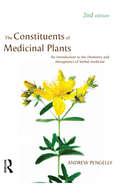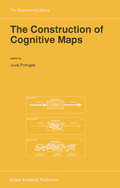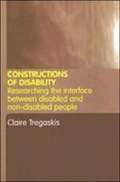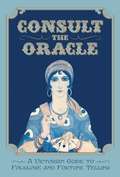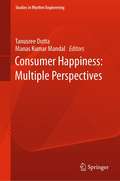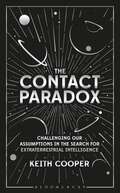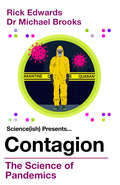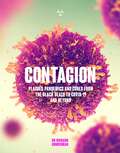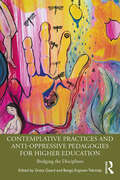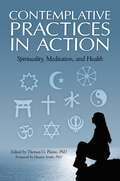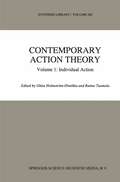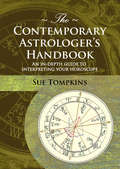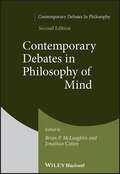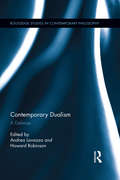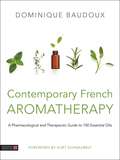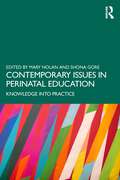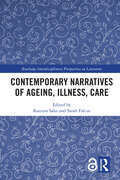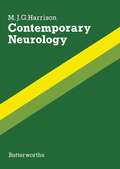- Table View
- List View
The Constituents of Medicinal Plants: An introduction to the chemistry and therapeutics of herbal medicine
by Andrew PengellyPengelly's user friendly text will encourage educators in medical science to consider using this material in the complementary medicine/nutraceuticals areas May I congratulate Andrew Pengelly for writing this text as it is going to be very popular with undergraduate students as well as more experienced readers.'D. Green, London Metropolitan University, UKThis unique book explains in simple terms the commonly occurring chemical constituents of medicinal plants. The major classes of plant constituents such as phenols, terpenes and polysaccharides, are described both in terms of their chemical structures and their pharmacological activities. Identifying specific chemical compounds provides insights into traditional and clinical use of these herbs, as well as potential for adverse reactions. Features include: * Over 100 diagrams of chemical structures* References to original research studies and clinical trials * References to plants commonly used throughout Europe, North America and Australasia.Written by an experienced herbal practitioner, The Constituents of Medicinal Plants seriously challenges any suggestion that herbal medicine remains untested and unproven, including as it does hundreds of references to original research studies and trials.Designed as an undergraduate text, the first edition of this book became an essential desktop reference for health practitioners, lecturers, researchers, producers and anyone with an interest in how medicinal herbs work. This edition has been extensively revised to incorporate up-to-date research and additional sections, including an expanded introduction to plant molecular structures, and is destined to become a classic in the literature of herbal medicine.
The Constituents of Medicinal Plants: An introduction to the chemistry and therapeutics of herbal medicine
by Andrew PengellyPengelly's user friendly text will encourage educators in medical science to consider using this material in the complementary medicine/nutraceuticals areas May I congratulate Andrew Pengelly for writing this text as it is going to be very popular with undergraduate students as well as more experienced readers.'D. Green, London Metropolitan University, UKThis unique book explains in simple terms the commonly occurring chemical constituents of medicinal plants. The major classes of plant constituents such as phenols, terpenes and polysaccharides, are described both in terms of their chemical structures and their pharmacological activities. Identifying specific chemical compounds provides insights into traditional and clinical use of these herbs, as well as potential for adverse reactions. Features include: * Over 100 diagrams of chemical structures* References to original research studies and clinical trials * References to plants commonly used throughout Europe, North America and Australasia.Written by an experienced herbal practitioner, The Constituents of Medicinal Plants seriously challenges any suggestion that herbal medicine remains untested and unproven, including as it does hundreds of references to original research studies and trials.Designed as an undergraduate text, the first edition of this book became an essential desktop reference for health practitioners, lecturers, researchers, producers and anyone with an interest in how medicinal herbs work. This edition has been extensively revised to incorporate up-to-date research and additional sections, including an expanded introduction to plant molecular structures, and is destined to become a classic in the literature of herbal medicine.
The Construction of Cognitive Maps (GeoJournal Library #32)
by Juval Portugaliand processes which are exclusive to humans in their encoding, storing, decoding and retrieving spatial knowledge for various tasks. The authors present and discuss connectionist models of cognitive maps which are based on local representation, versus models which are based on distributed representation, as well as connectionist models concerning language and spatial relations. As is well known, Gibson's (1979) ecological approach suggests a view on cognition which is diametrically different from the classical main stream view: perception (and thus cognition) is direct, immediate and needs no internal information processing, and is thus essentially an external process of interaction between an organism and its external environment. The chapter by Harry Heft introduces J. J. Gibson's ecological approach and its implication to the construction of cognitive maps in general and to the issue of wayfinding in particular. According to Heft, main stream cognitive sciences are essentially Cartesian in nature and have not as yet internalized the implications of Darwin's theory of evolution. Gibson, in his ecological approach, has tried to do exactly this. The author introduces the basic terminology of the ecological approach and relates its various notions, in particular optic flow, nested hierarchy and affordances, to navigation and the way routes and places in the environment are learned.
Constructions Of Disability: Researching The Interface Between Disabled And Non-disabled People
by Claire TregaskisDiscusses the meaning of inclusion through the exploration of the interactions between disabled and non-disabled people at a community leisure centre. The text extends the focus of disability research to pay more attention to the ways that activity in the disabled and non-disabled interface is implicated in reinforcing or challenging oppression.
Consult the Oracle: A Victorian Guide to Folklore and Fortune Telling
by Gabriel Nostradamus"If you sing before breakfast you will cry before supper...' In their own words, what it meant for Victorians to dream of actors, April Fools, herrings or a railway ticket – why it was advised to throw a black snail by its horns over the left shoulder for good luck – and why it is essential to inform bees of a death in the family. "If one drops a knife, a woman is coming; a fork, a man is coming; a spoon, a fool.†? Tappings on tables, questionable curatives, old wives' tales and whispers from beyond the grave – Victorians were fascinated by the supernatural. Consult the Oracle was where they might have turned when they needed to identify a witch, interpret an omen or dream, required a natural cure or wanted to divine their future with a pack of cards – or simply wished to understand what the supernatural meant to them and their ancestors. First published in 1899, it offered a layman's guide to 'matters magical and mysterious', and today is a quirky glimpse of a supernatural age now lost, by turns haunting and hilarious.
Consumer Happiness: Multiple Perspectives (Studies in Rhythm Engineering)
by Tanusree Dutta Manas Kumar MandalThis book helps quench the quest of knowledge of academicians, researchers, and others interested in developing a complete and critical understanding of consumer happiness. The relentless search of happiness by humans is sought in different ways. Scientific discussion on happiness for long was considered a forte of Philosophers. Other disciplines seldom delved into this. But today not only science but neuroscience, marketing, and other varied fields have started delving into it and have developed a keen interest. The book has been conceptualized on this line of thinking and thus divided into two parts. The first part is customized towards understanding various perspectives of happiness and the relative importance of knowing the same. The first chapter of this section is on the biological perspective of happiness. The second is titled ‘Behavioural perspective’. The third chapter is an attempt to elucidate the cultural perspective of the concept of happiness. The fourth is on the role of technology in inducing happiness. Fifth and sixth are on theories of happiness and measuring happiness, respectively. Knowledge about the different perspective and theories has a wide range of benefits. It informs us about how the brain works, interprets, and reacts. This theoretical understanding helps us to move beyond the trial and error methods towards a more scientific underpinning of adoption of measures that would generate long-lasting happiness in consumers.The second part of the book is dedicated toward understanding consumer happiness from a neuroscience perspective, i.e. keeping consumer happy. This segment has ten chapters. The first is on differentiating the concept of happiness from satisfaction. The second is on sensory marketing and happiness. The third deals with the store design and shelving of products to generate happiness. Fourth and fifth chapters relate to persuading the consumers. While the fourth chapter is on developing persuasive messages and the fifth is on subliminal messaging sixth chapter is on pricing and seventh on advertising. The eighth chapter highlights the role of emotions and the ninth is on the different factors that induce happiness in consumers. The last chapter is about raising some unanswered questions and food for thought for readers. Together the contents of the book make for a complete understanding of the concept of happiness and how it is shaping the world of marketing. Addressing the ‘what’ and ‘how’ of consumer happiness in the same book makes the book comprehensive.
The Contact Paradox: Challenging our Assumptions in the Search for Extraterrestrial Intelligence
by Keith CooperIn 1974 a message was beamed towards the stars by the giant Arecibo telescope in Puerto Rico, a brief blast of radio waves designed to alert extraterrestrial civilisations to our existence. Of course, we don't know if such civilisations really exist. For the past six decades a small cadre of researchers have been on a quest to find out, as part of SETI, the search for extraterrestrial intelligence. So far, SETI has found no evidence of extraterrestrial life, but with more than a hundred billion stars in our Galaxy alone to search, the odds of quick success are stacked against us. The silence from the stars is prompting some researchers, inspired by the Arecibo transmission, to transmit more messages into space, in an effort to provoke a response from any civilisations out there that might otherwise be staying quiet. However, the act of transmitting raises troubling questions about the process of contact. We look for qualities such as altruism and intelligence in extraterrestrial life, but what do these mean to humankind? Can civilisations survive in the Universe long enough for us to detect them, and what can their existence, or lack thereof, reveal to us about our future prospects? Can we learn something about our own history when we explore what happens when two civilisations come into contact? Finally, do the answers tell us that it is safe to transmit, even though we know nothing about extraterrestrial life, or as Stephen Hawking argued, are we placing humanity in jeopardy by doing so?In The Contact Paradox, author Keith Cooper looks at how far SETI has come since its modest beginnings, and where it is going, by speaking to the leading names in the field and beyond. SETI forces us to confront our nature in a way that we seldom have before – where did we come from, where are we going, and who are we in the cosmic context of things? This book considers the assumptions that we make in our search for extraterrestrial life, and explores how those assumptions can teach us about ourselves.
Contagion: The Science of Pandemics
by Rick EdwardsFrom the bestselling authors behind Science(ish) and Hollywood Wants to Kill You...A fascinating free ebook about the science of viruses - all told through the Hollywood blockbuster Contagion.Viruses can spread faster than fear - but where do they come from? What makes them so powerful? And how do we stop them spreading like wildfire? With wit and intelligence, Rick Edwards and Dr Michael Brooks explore the science of pandemics, from the Black Death to the Coronavirus. Packed with illustrations and fascinating facts, Contagion is a captivating handbook to the real science behind the greatest public health emergency of recent times.
Contagion: Plagues, Pandemics and Cures from the Black Death to Covid-19 and Beyond
by Richard GundermanAs the outbreak of a new and deadly form of coronavirus dominates headlines and triggers fear and global recession, now is a good time to reflect on the history and science of transmissible diseases. Behind every disease is a story, from the natural history of the disease and its course in the individual, to the tale of the disease's description, discovery and treatment. From the impact of tuberculosis on English dynastic history to the makeup of our DNA; from the deadliest plagues of the ancient world to twenty-first century pandemics; and from the ravages of the Black Death to the discovery of antibodies, transmissible diseases have an incredible variety of tales to tell. Contagion explores some of the most notorious, grisly, and pernicious communicable diseases in history, revealing their hidden stories. In addition to discussing their symptoms, causes, prevention, and treatment, Richard Gunderman also discusses their impact on notable figures in history, from soldiers to monarchs; the extraordinary contributions of the scientists and physicians who battled them; as well as their impacts on world history and human evolution. Here are the exploits of Edward Jenner, who invented the first vaccine; John Snow, the first person to study disease scientifically; Louis Pasteur, who established the germ theory of infection, along with a myriad other remarkable stories in the never ending struggle between humanity and disease. The narrative is brought right up to date with the desperate battle to stem the Covid-19 pandemic and discover a vaccine. Renowned medical expert Dr Richard Gunderman shows how disease has shaped the evolution of our species and, if we don't take the proper steps, may yet threaten our very existence on this planet.
Contemplative Practices and Anti-Oppressive Pedagogies for Higher Education: Bridging the Disciplines
by Greta Gaard Bengü Ergüner-TekinalpThis volume explores mindfulness and other contemplative approaches as strategic tools for cultivating anti-oppressive pedagogies in higher education. Research confirms that simply providing students with evidence and narratives of economic, social, and environmental injustices proves insufficient in developing awareness and eliciting responses of empathy, solidarity, and a desire to act for change. From the environmental humanities to the environmental sciences, legal studies, psychology, and counseling, educators from a range of geographical and disciplinary standpoints describe their research-based mindfulness pedagogies. Chapters explore how to interrupt and interrogate oppression through contemplative teaching tools, assignments, and strategies that create greater awareness and facilitate deeper engagement with learning contents, contexts, and communities. Providing a framework that facilitates awareness of the links between historic and current oppression, self-identity, and trauma, and creating a transformative learning experience through mindfulness, this book is a must-read for faculty and educators interested in intersections of mindfulness, contemplative pedagogies, and anti-oppression.
Contemplative Practices and Anti-Oppressive Pedagogies for Higher Education: Bridging the Disciplines
by Greta Gaard Bengü Ergüner-TekinalpThis volume explores mindfulness and other contemplative approaches as strategic tools for cultivating anti-oppressive pedagogies in higher education. Research confirms that simply providing students with evidence and narratives of economic, social, and environmental injustices proves insufficient in developing awareness and eliciting responses of empathy, solidarity, and a desire to act for change. From the environmental humanities to the environmental sciences, legal studies, psychology, and counseling, educators from a range of geographical and disciplinary standpoints describe their research-based mindfulness pedagogies. Chapters explore how to interrupt and interrogate oppression through contemplative teaching tools, assignments, and strategies that create greater awareness and facilitate deeper engagement with learning contents, contexts, and communities. Providing a framework that facilitates awareness of the links between historic and current oppression, self-identity, and trauma, and creating a transformative learning experience through mindfulness, this book is a must-read for faculty and educators interested in intersections of mindfulness, contemplative pedagogies, and anti-oppression.
Contemplative Practices in Action: Spirituality, Meditation, and Health
by Thomas G. PlanteThis groundbreaking primer illuminates contemplative methods that can improve mental and physical health.Contemplative practices, from meditation to Zen, are growing in popularity as methods to inspire physical and mental health. Contemplative Practices in Action: Spirituality, Meditation, and Health offers readers an introduction to these practices and the ways they can be used in the service of well being, wisdom, healing, and stress reduction.Bringing together various traditions from the East and West, this thought-provoking work summarizes the history of each practice, highlights classic and emerging research proving its power, and details how each practice is performed. Expert authors offer step-by-step approaches to practice methods including the 8-Point Program of Passage Meditation, Centering Prayer, mindful stress management, mantram meditation, energizing meditation, yoga, and Zen. Beneficial practices from Christian, Buddhist, Jewish, Hindu, and Islamic religions are also featured. Vignettes illustrate each of the practices, while the contributors explain how and why they are effective in facing challenges as varied as the loss of a partner or child, job loss, chronic pain or disease, or psychological disorders.
Contemporary Action Theory Volume 1: Individual Action (Synthese Library #266)
by RaimoTuomela GhitaHolmström-HintikkaContemporary Action Theory, Volume I (Individual Action) is concerned with topics in philosophical action theory such as reasons and causes of action, intentions, freedom of will and of action, omissions and norms in legal and ethical contexts, as well as activity, passivity and competence from medical points of view. Cognitive trying, freedom of the will and agent causation are challenges in the discussion on computers in action. The Volume consists of contributions by leading experts in the field written specifically for this volume. No comparable volume currently exists.
The Contemporary Astrologer's Handbook: An In-depth Guide to Interpreting Your Horoscope (Flare "astrology Now" Ser.)
by Sue TompkinsThe Contemporary Astrologer's Handbook is the long-awaited, complete guide to horoscope interpretation by Sue Tompkins, author of the modern classic Aspects in Astrology. Drawing on Sue's 30 years of experience as a leading light in her field, this manual presents an in-depth exploration of the planets, signs, houses and aspects, and guides the reader through the essential stages of chart delineation. Rich in material for beginner and professional alike, there is simply no other book like it. Included are insights into Chiron and the Centaurs, co-written with Melanie Reinhart.
Contemporary Debates in Philosophy of Mind (Contemporary Debates in Philosophy)
by Brian P. McLaughlin Jonathan CohenA timely collection of debates concerning the major themes and topics in philosophy of mind, fully updated with new topics covering the latest developments in the field Contemporary Debates in Philosophy of Mind provides a lively and engaging introduction to the conceptual background, ongoing debates, and contentious issues in the field today. Original essays by more than 30 of the discipline’s most influential thinkers offer opposing perspectives on a series of contested questions regarding mental content, physicalism, the place of consciousness in the physical world, and the nature of perception and mental capacities. Written to appeal to non-specialists and professional philosophers alike, the second edition of Contemporary Debates in Philosophy of Mind features five entirely new debates on the relation between perception and cognition, whether pain is a natural kind, whether perception is best understood through representational content or direct contact with the world, whether we need imagination that goes beyond imagery and supposition, and whether perceptual contents are general, particular, or a hybrid. Presents 15 sets of specially commissioned essays with opposing viewpoints on central topics in philosophy of mind Offers head-to-head debates on central topics such as consciousness, intentionality, normativity, mental causation, materialism, and perception Provides a dynamic view of contemporary thinking about fundamental and controversial issues Includes a thorough introduction providing a comprehensive background to the issues explored in each debate Part of Wiley-Blackwell’s acclaimed Contemporary Debates in Philosophy series, Contemporary Debates in Philosophy of Mind, Second Edition is essential reading for undergraduate and graduate students, academics, professional philosophers, and sophisticated general readers with an interest in the subject.
Contemporary Debates in Philosophy of Mind (Contemporary Debates in Philosophy)
by Brian P. McLaughlin Jonathan CohenA timely collection of debates concerning the major themes and topics in philosophy of mind, fully updated with new topics covering the latest developments in the field Contemporary Debates in Philosophy of Mind provides a lively and engaging introduction to the conceptual background, ongoing debates, and contentious issues in the field today. Original essays by more than 30 of the discipline’s most influential thinkers offer opposing perspectives on a series of contested questions regarding mental content, physicalism, the place of consciousness in the physical world, and the nature of perception and mental capacities. Written to appeal to non-specialists and professional philosophers alike, the second edition of Contemporary Debates in Philosophy of Mind features five entirely new debates on the relation between perception and cognition, whether pain is a natural kind, whether perception is best understood through representational content or direct contact with the world, whether we need imagination that goes beyond imagery and supposition, and whether perceptual contents are general, particular, or a hybrid. Presents 15 sets of specially commissioned essays with opposing viewpoints on central topics in philosophy of mind Offers head-to-head debates on central topics such as consciousness, intentionality, normativity, mental causation, materialism, and perception Provides a dynamic view of contemporary thinking about fundamental and controversial issues Includes a thorough introduction providing a comprehensive background to the issues explored in each debate Part of Wiley-Blackwell’s acclaimed Contemporary Debates in Philosophy series, Contemporary Debates in Philosophy of Mind, Second Edition is essential reading for undergraduate and graduate students, academics, professional philosophers, and sophisticated general readers with an interest in the subject.
Contemporary Dualism: A Defense (Routledge Studies in Contemporary Philosophy)
by Andrea Lavazza Howard RobinsonOntological materialism, in its various forms, has become the orthodox view in contemporary philosophy of mind. This book provides a variety of defenses of mind-body dualism, and shows (explicitly or implicitly) that a thoroughgoing ontological materialism cannot be sustained. The contributions are intended to show that, at the very least, ontological dualism (as contrasted with a dualism that is merely linguistic or epistemic) constitutes a philosophically respectable alternative to the monistic views that currently dominate thought about the mind-body (or, perhaps more appropriately, person-body) relation.
Contemporary Dualism: A Defense (Routledge Studies in Contemporary Philosophy)
by Andrea Lavazza Howard RobinsonOntological materialism, in its various forms, has become the orthodox view in contemporary philosophy of mind. This book provides a variety of defenses of mind-body dualism, and shows (explicitly or implicitly) that a thoroughgoing ontological materialism cannot be sustained. The contributions are intended to show that, at the very least, ontological dualism (as contrasted with a dualism that is merely linguistic or epistemic) constitutes a philosophically respectable alternative to the monistic views that currently dominate thought about the mind-body (or, perhaps more appropriately, person-body) relation.
Contemporary French Aromatherapy: A Pharmacological and Therapeutic Guide to 100 Essential Oils
by Dominique BaudouxThis manual from the French school of aromatherapy is a comprehensive guide to 100 essential oils offering practical and rigorous information for integrative and complementary health practitioners. Everything you need to know in terms of botany, quality criteria, biochemistry and toxicity is explained, alongside guidance on therapeutic application to improve health and wellbeing.Due to their diverse and varied properties, essential oils can be used across many different complementary health modalities. Whilst recognizing the complexity and the importance of the molecular structure of plant essences, this guide incorporates information about energetic approaches and the role of olfaction in supporting therapeutic practices.This first English translation of Dominique Baudoux's work provides the reader with a wealth of knowledge, research and guidance on application, including a large number of validated formulas for treatment.
Contemporary French Aromatherapy: A Pharmacological and Therapeutic Guide to 100 Essential Oils
by Dominique BaudouxThis manual from the French school of aromatherapy is a comprehensive guide to 100 essential oils offering practical and rigorous information for integrative and complementary health practitioners. Everything you need to know in terms of botany, quality criteria, biochemistry and toxicity is explained, alongside guidance on therapeutic application to improve health and wellbeing.Due to their diverse and varied properties, essential oils can be used across many different complementary health modalities. Whilst recognizing the complexity and the importance of the molecular structure of plant essences, this guide incorporates information about energetic approaches and the role of olfaction in supporting therapeutic practices.This first English translation of Dominique Baudoux's work provides the reader with a wealth of knowledge, research and guidance on application, including a large number of validated formulas for treatment.
Contemporary Issues in Perinatal Education: Knowledge into Practice
by Mary Nolan Shona GoreProviding essential knowledge and understanding that midwives, health visitors, nursery nurses and lay birth and early parenting educators need to deliver effective and evidence-based education to all new parents and families, this book explores key issues in perinatal education. Bringing together research and thinking around preconception and birth, infant sleep, nutrition, attachment and development, it also includes chapters on topics of growing importance, such as preconception education, LGBTQ+ parent education, the role of parenting advice, parent education across different cultures and teaching antenatal classes online. Each chapter includes a key knowledge update and pointers for practice. This wide-ranging and practical text is an important read for all those supporting new parents from pregnancy through the first 1000 days, especially those delivering antenatal care and birth and early parenting education.
Contemporary Issues in Perinatal Education: Knowledge into Practice
by Mary Nolan Shona GoreProviding essential knowledge and understanding that midwives, health visitors, nursery nurses and lay birth and early parenting educators need to deliver effective and evidence-based education to all new parents and families, this book explores key issues in perinatal education. Bringing together research and thinking around preconception and birth, infant sleep, nutrition, attachment and development, it also includes chapters on topics of growing importance, such as preconception education, LGBTQ+ parent education, the role of parenting advice, parent education across different cultures and teaching antenatal classes online. Each chapter includes a key knowledge update and pointers for practice. This wide-ranging and practical text is an important read for all those supporting new parents from pregnancy through the first 1000 days, especially those delivering antenatal care and birth and early parenting education.
Contemporary Narratives of Ageing, Illness, Care (Routledge Interdisciplinary Perspectives on Literature)
by Katsura Sako Sarah FalcusThis collection of essays explores cultural narratives of care in the contexts of ageing and illness. It includes both text-based and practice-based contributions by leading and emerging scholars in humanistic studies of ageing. They consider care not only in film (feature and documentary) and literature (novel, short story, children’s picturebook) but also in the fields of theatre performance, photography and music. The collection has a broad geographical scope with case studies and primary texts from Europe and North America but also from Hong Kong, Japan, Australia, Argentina and Mexico. The volume asks what care, autonomy and dependence may mean and how these may be inflected by social and cultural specificities. Ultimately, it invites us to reflect on our relations to others as we face the global and local challenges of both the pandemic and ageing societies.
Contemporary Narratives of Ageing, Illness, Care (Routledge Interdisciplinary Perspectives on Literature)
by Katsura Sako Sarah FalcusThis collection of essays explores cultural narratives of care in the contexts of ageing and illness. It includes both text-based and practice-based contributions by leading and emerging scholars in humanistic studies of ageing. They consider care not only in film (feature and documentary) and literature (novel, short story, children’s picturebook) but also in the fields of theatre performance, photography and music. The collection has a broad geographical scope with case studies and primary texts from Europe and North America but also from Hong Kong, Japan, Australia, Argentina and Mexico. The volume asks what care, autonomy and dependence may mean and how these may be inflected by social and cultural specificities. Ultimately, it invites us to reflect on our relations to others as we face the global and local challenges of both the pandemic and ageing societies.
Contemporary Neurology
by M. J. G. HarrisonContemporary Neurology compiles a large series of papers on the commonest neurological problems. This book discusses the management of epilepsy, involuntary movements, nerve and muscle diseases, and multiple sclerosis. The areas on infections, cerebrovascular disease, trauma, intracranial pressure, and vertebral column are also elaborated. This text likewise describes medical procedures on how to do a lumbar and cisternal puncture. Other topics include headache in children, hyperventilation, dizziness, funny turns—neurological, dysarthria, facial pain, and nystagmus. The weakness of the legs, loss of memory, coma, brain death, complications of alcoholism, and stupor and akinetic mutism are also covered. This publication is valuable to clinicians and examination candidates preparing for the DPM, MRCP (UK) and Neurology/Psychiatry “Boards".
